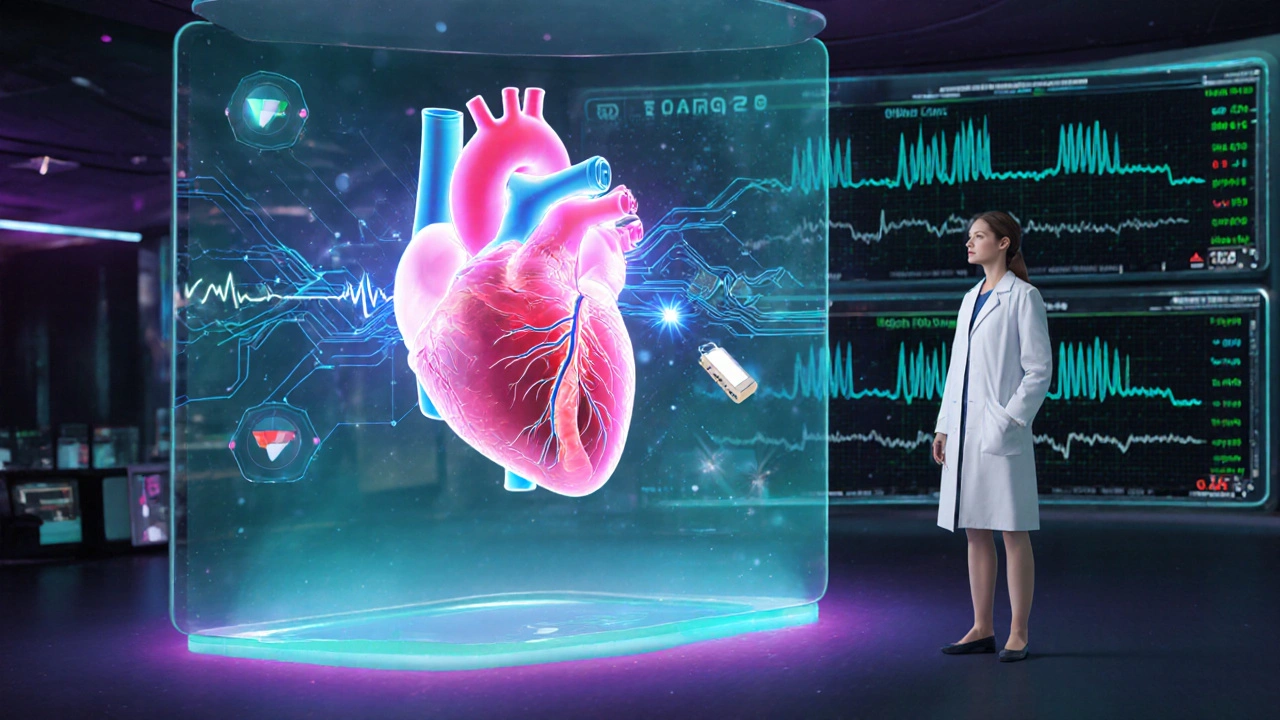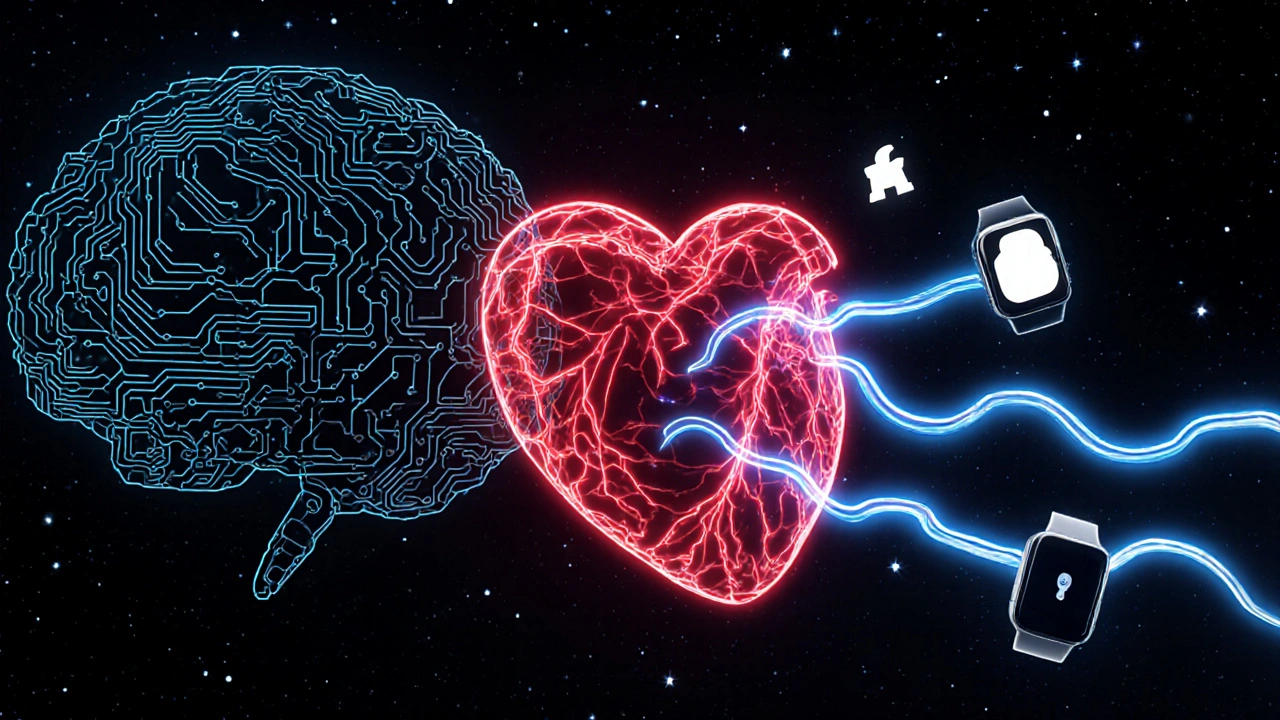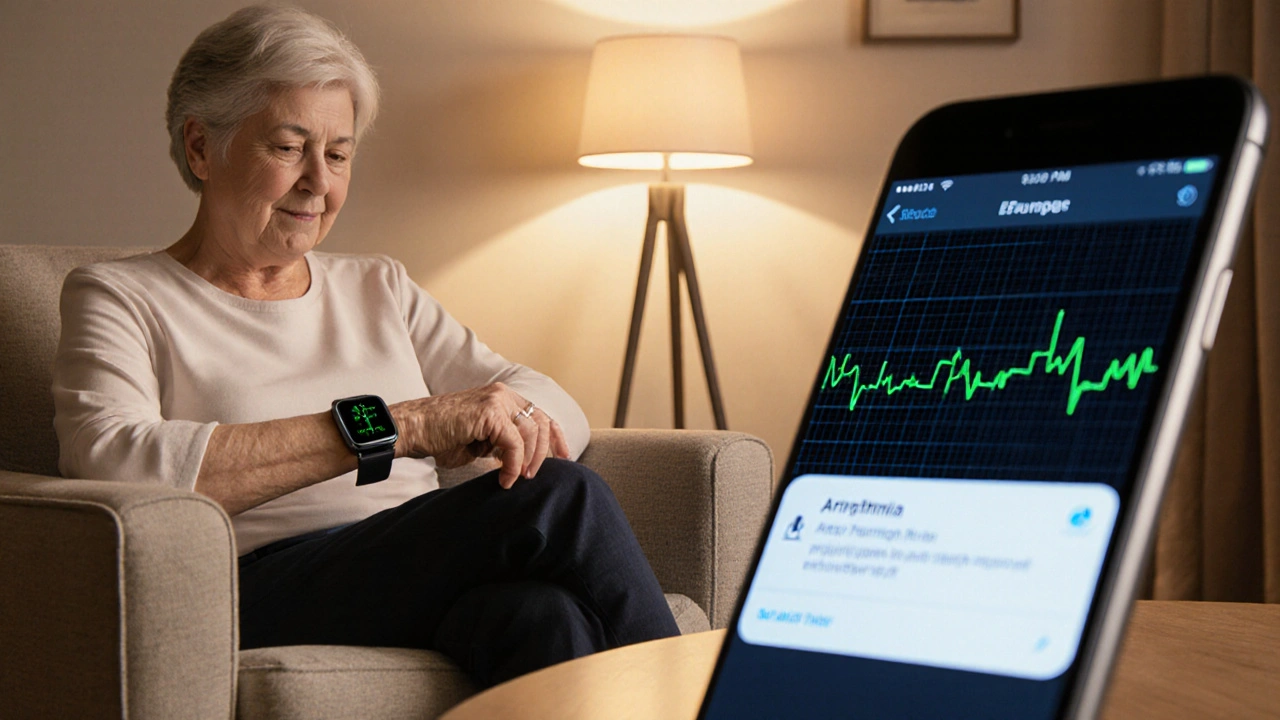Arrhythmia Detection Cost Estimator
This tool estimates potential cost savings from using emerging technologies for arrhythmia detection and management compared to traditional methods.
When you feel that flutter or missed beat, it’s more than a nuisance - it can be a sign of irregular heartbeat, also called arrhythmia. Traditional check‑ups often miss early episodes, leaving patients in the dark. Today, a wave of emerging technologies is flipping that script, letting people spot problems instantly and even guide treatment from the comfort of home.
TL;DR
- AI‑driven analysis can flag dangerous rhythms within seconds.
- Wearable ECGs and photoplethysmography (PPG) give near‑continuous monitoring.
- Implantable loop recorders capture weeks‑long data for elusive arrhythmias.
- Telemedicine platforms let cardiologists adjust meds in real time.
- Combining these tools cuts emergency visits by up to 30% (2024 UK health data).
Why Detecting Arrhythmia Early Matters
Every year, an estimated 350,000 people in the UK are diagnosed with atrial fibrillation alone, and the number climbs as the population ages. Missed or delayed diagnosis leads to strokes, heart failure, and costly hospital stays. The goal is simple: catch the irregular beat before it spirals into a life‑changing event.
Emerging Tech Landscape
Let’s break down the main players reshaping cardiac care.
- Artificial intelligence - software that learns patterns from massive ECG datasets.
- Wearable ECG monitor - chest‑strap or smartwatch sensors that record a full‑lead ECG on demand.
- Photoplethysmography (PPG) - optical sensors that infer pulse‑wave changes through the skin.
- Implantable loop recorder - tiny sub‑cutaneous devices that log heart rhythm for months.
- Telemedicine platform - cloud‑based portals where clinicians view live data and prescribe adjustments.
- Machine learning algorithm - the analytical engine that turns raw signals into actionable alerts.
How AI Enhances irregular heartbeat detection
AI isn’t just a buzzword; it’s the engine that makes sense of millions of beats per day. A typical workflow looks like this:
- Sensor streams raw ECG or PPG data to a secure server.
- A machine learning algorithm parses the signal in real time.
- If the pattern matches a known arrhythmia, an alert pops up on the user’s phone and on the clinician’s dashboard.
Studies from the UK NHS Digital (2023) showed AI‑based triage reduced false‑negative atrial fibrillation detections from 12% to 3%.
Wearable ECG Monitors - From Gym to Bedside
Modern wearables go beyond step counting. Devices like the Apple Watch Series9 or the UK‑made CardioSense strap embed FDA‑cleared ECG leads. When you tap the screen, the sensor records a 30‑second rhythm strip that’s sent straight to an app.
Key benefits:
- Instant visual of heart rhythm - you see the squiggle yourself.
- Data stored securely for later review.
- Battery life up to 48hours for continuous monitoring.
One real‑world case involved a 58‑year‑old teacher who noticed occasional palpitations. A quick wrist‑ECG caught a brief episode of supraventricular tachycardia, prompting medication that stopped the symptoms within weeks.

Photoplethysmography - Light‑Based Heart Sensing
If you’ve ever used a fitness tracker, you’ve already relied on PPG. By shining a green LED into the skin and measuring reflected light, the sensor tracks blood volume changes. While not as precise as a full ECG, advanced AI models can infer atrial fibrillation with >95% sensitivity when the data set is large enough.
PPG excels for people who can’t wear a chest strap - think seniors with arthritis. The technology also integrates into smartphones, letting anyone place a fingertip on the camera for a quick screening.
Implantable Loop Recorders - The Long‑Term Detective
When symptoms are sporadic, a wearable may miss them. Enter the implantable loop recorder. A tiny device about the size of a grain of rice is placed just under the skin of the upper chest. It continuously records electrical activity, storing any episode that meets pre‑set criteria.
Advantages include:
- Up to three years of uninterrupted data.
- Automatic detection of pauses, tachycardia, and bradycardia.
- Remote transmission via Bluetooth to the patient’s smartphone.
In a 2022 multicenter trial, loop recorders identified the cause of unexplained fainting in 68% of participants, far higher than standard Holter monitors (23%).
Telemedicine Platforms - Bringing the Cardiology Office Home
All the data streams converge on a telemedicine platform. Clinicians access a dashboard that shows real‑time trends, flagged alerts, and even predictive risk scores generated by AI.
Key features:
- Secure video consults triggered by an abnormal reading.
- Prescription adjustments sent directly to pharmacy apps.
- Patient education videos that explain each arrhythmia type.
A pilot in Bristol’s primary‑care network reduced emergency department referrals for atrial fibrillation by 27% during the first year of rollout.
Treatment Integration - From Data to Action
Detecting an irregular heartbeat is only half the battle. The real power lies in using that data to guide treatment.
- Medication titration: AI predicts how a beta‑blocker will affect heart rate variability, letting doctors start at a lower dose.
- Catheter ablation planning: High‑resolution ECG maps highlight the exact electrical pathway to target.
- Lifestyle coaching: Wearable data ties spikes in caffeine or alcohol consumption to arrhythmia episodes, prompting personalized advice.
Patients who follow a data‑driven plan report a 40% reduction in symptom burden compared with standard care (European Heart Journal, 2024).
Practical Checklist for Anyone Considering These Tools
- Ask your GP if you qualify for a wearable ECG prescription.
- Check whether the device’s app is compatible with NHS digital services.
- If episodes are rare, discuss an implantable loop recorder with a cardiologist.
- Make sure you have a reliable internet connection for telemedicine uploads.
- Keep a symptom diary - even a quick note on your phone helps AI fine‑tune its models.
Future Outlook - What’s Next?
Within the next five years, we’ll likely see three game‑changing developments:
- Edge AI on the device: Chips will analyze data locally, sending only critical alerts, which improves privacy.
- Multi‑modal sensing: Combining ECG, PPG, and even acoustic heart sounds for a richer picture.
- Predictive genomics integration: AI will cross‑reference genetic risk scores with real‑time rhythm data to predict arrhythmia before it happens.
Until then, the tools we have now already give patients and doctors a far clearer view of the heart’s rhythm, turning uncertainty into actionable insight.
| Technology | Invasiveness | Monitoring Duration | Typical Accuracy* | Estimated Cost (UK) |
|---|---|---|---|---|
| Wearable ECG | Non‑invasive | Continuous (up to 48h per charge) | 96% for atrial fibrillation | £250-£500 |
| Implantable Loop Recorder | Minimally invasive (sub‑cutaneous) | Months to years | 99% for sustained episodes | £2,200-£3,500 (procedure + device) |
| AI‑Enabled Telemedicine | Non‑invasive (software layer) | Real‑time | Depends on sensor; improves +15% over manual read | Subscription £15-£30/mo |

Frequently Asked Questions
Can a smartwatch replace a medical ECG?
Smartwatches provide a quick snapshot and are great for spotting obvious irregularities, but they don’t replace a full 12‑lead ECG when a detailed diagnosis is required. Use them as a first‑line alert and follow up with a clinician.
Is the data from these devices private?
Most reputable platforms encrypt data both at rest and in transit and comply with UK GDPR. Look for certifications like ISO27001 before signing up.
How long does an implantable loop recorder last?
Battery life typically ranges from three to five years, after which the device can be safely removed or replaced.
Do I need a prescription for wearable ECGs?
In the UK, many consumer wearables are classified as medical devices and can be bought over the counter, but a GP can prescribe a clinically‑validated version if you have a known condition.
Can AI misinterpret normal heartbeats as arrhythmia?
False positives do happen, especially with noisy data. That’s why alerts always trigger a clinician review before any treatment change.

Brian Rice
September 30, 2025 AT 21:36The proliferation of AI‑driven cardiac monitors raises profound ethical concerns that cannot be dismissed as mere technological hype. While the benefits are undeniable, we must impose rigorous standards for data privacy, informed consent, and equitable access. Failure to do so will entrench existing health disparities and undermine public trust. Regulators should require transparent algorithms and independent audits before any device reaches the market. Moreover, clinicians bear a moral duty to validate each alert rather than delegate judgment entirely to machines. In short, progress must be paired with responsibility, lest we sacrifice patient autonomy on the altar of convenience.
Stan Oud
September 30, 2025 AT 22:43Most people hail wearables as a cure‑all but the data quality often leaves much to be desired; battery life is another hidden cost – you get a flash of insight then the device dies.
Ryan Moodley
September 30, 2025 AT 23:50Imagine a world where your heartbeat whispers secrets to an algorithm, and that algorithm decides whether you live or die; the line between biology and code blurs into a haunting echo of destiny, and we stand at the precipice of a new epoch where mortality is quantified in megabytes.
carol messum
October 1, 2025 AT 00:56Wearables are handy because you can just glance at your wrist and know if something’s off without scheduling a doctor visit.
Jennifer Ramos
October 1, 2025 AT 02:03I love how the new loop recorders give us months of data, making it easier to pinpoint elusive arrhythmias 😊. It’s a game‑changer for patients who can’t tolerate frequent appointments.
Grover Walters
October 1, 2025 AT 03:10From a systems perspective, integrating continuous ECG streams into electronic health records creates a feedback loop that could refine therapeutic protocols over time. However, the latency of clinical decision‑making must be considered to avoid over‑reliance on automated alerts.
Amy Collins
October 1, 2025 AT 04:16The signal‑to‑noise ratio in PPG sensors is often compromised by motion artefacts, which forces developers to implement adaptive filtering algorithms that can be computationally intensive.
Rita Joseph
October 1, 2025 AT 05:23If you’re starting out with a smartwatch ECG, first ensure the device is FDA‑cleared and that the companion app is linked to your NHS portal. Then, record a baseline reading in a calm environment, compare it with a clinical 12‑lead ECG, and calibrate the thresholds accordingly. This systematic approach will reduce false positives and build confidence in the technology.
abhi sharma
October 1, 2025 AT 06:30Oh great, another gadget that tells you your heart is fine until it isn’t.
mas aly
October 1, 2025 AT 07:36The ability to upload continuous rhythm data to a cloud platform means clinicians can review trends remotely, which is especially useful for patients living in rural areas where specialist access is limited.
Abhishek Vora
October 1, 2025 AT 08:43While you dismiss battery constraints as trivial, consider that the aggregate power consumption across millions of devices contributes to a measurable increase in grid demand, thereby indirectly influencing macro‑energy policies.
Belle Koschier
October 1, 2025 AT 09:50Absolutely, the longitudinal data set from loop recorders also feeds machine‑learning models that become more accurate with each new patient, creating a virtuous cycle of improvement.
Allison Song
October 1, 2025 AT 10:56In contemplating the integration of AI with cardiology, the physician’s role evolves into a collaborator who supervises and interprets data rather than being replaced.
Joseph Bowman
October 1, 2025 AT 12:03Some argue that the data harvested from personal heart monitors could be repurposed by insurance firms to price‑adjust policies, effectively turning your pulse into a credit score for health.
Singh Bhinder
October 1, 2025 AT 13:10If you’re on a budget, many smartphone apps can convert the camera into a rudimentary PPG sensor, though they lack the clinical validation of dedicated wearables.
Kelly Diglio
October 1, 2025 AT 14:16The adoption of AI‑enabled telemedicine platforms represents a paradigm shift in how arrhythmia management is delivered.
First, real‑time data transmission eliminates the need for patients to travel to clinics solely for routine ECG checks.
Second, algorithmic triage prioritizes high‑risk alerts, allowing clinicians to allocate their time more efficiently.
Third, the integration with electronic health records ensures that historical data is readily available for longitudinal analysis.
Fourth, patients gain immediate feedback, which can reinforce adherence to medication regimens.
Fifth, the cost structure shifts from episodic fees to subscription models, potentially lowering barriers for continuous monitoring.
Sixth, the scalability of cloud‑based solutions means that remote or underserved regions can benefit without massive infrastructure investments.
Seventh, rigorous validation studies have demonstrated that AI‑driven rhythm classification achieves sensitivity and specificity comparable to expert cardiologists.
Eighth, the transparency of model decision paths is improving, with explainable‑AI techniques highlighting which waveform features triggered an alert.
Ninth, data privacy concerns are being addressed through end‑to‑end encryption and compliance with GDPR and HIPAA frameworks.
Tenth, clinicians still retain ultimate authority, as alerts serve as decision‑support rather than autonomous prescriptions.
Eleventh, patient education modules embedded within the platform empower users to understand their condition and lifestyle influences.
Twelfth, insurers are beginning to reimburse for remote monitoring when clinical outcomes demonstrate reduced hospital admissions.
Thirteenth, ongoing research aims to integrate genomic risk scores with wearable data, moving toward truly predictive cardiology.
Finally, as these technologies mature, the healthcare system must adapt its training curricula to prepare the next generation of physicians for a digitally augmented practice.
Carmelita Smith
October 1, 2025 AT 15:23Data security is key – encrypt everything! 🔐
Liam Davis
October 1, 2025 AT 16:30Indeed, the outlined benefits align with current literature; however, implementation challenges such as interoperability standards, clinician workflow integration, and patient digital literacy must be addressed comprehensively.
Arlene January
October 1, 2025 AT 17:36Hey folks, keep sharing your heart stories – every beat logged is a step toward a healthier community!
Kaitlyn Duran
October 1, 2025 AT 18:43It’s wild how a simple fingertip on a phone can reveal rhythm patterns that once required a hospital‑grade machine.